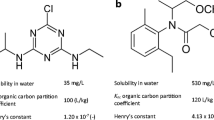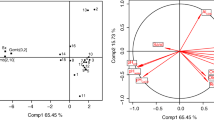Abstract
A study was conducted to determine the fate of the herbicide metolachlor in a tidal wetland soil located along the James River in Virginia, USA. Soil adsorption/desorption and mineralization characteristics and mobility of metolachlor were determined on the Levy tidal wetland soil. The metolachlor Kd value was 65.8 L kg−1 and Koc value was 810 L kg−1 C−1, which are much greater than would be found on typical agricultural soils. After four 24-h desorption periods, the total amount of metolachlor that desorbed ranged from 16 to 22% of the amount initially adsorbed. Metolachlor mineralization was about 0.46% of the amount applied after 84 days, which indicates that it does not mineralize very readily in the Levy soil. The amount of metolachlor that leached from the soil columns averaged 1.64% of the amount applied after 84 days, showing a low degree of mobility. These results suggest that the Levy tidal wetland soil can function as an effective filter of metolachlor and other similar herbicides that enter via agricultural runoff, protecting surface and ground waters.
Similar content being viewed by others
Literature Cited
Albanis, T. A., G. D. Theocharis, and M. K. Kourgia. 1994. Transportation of pesticides in estuaries of the Axios. Laoudias and Aliakmon rivers (Thermaikos Gulf), Greece, Science of The Total Environment 156:11–22.
Atkinson, R. B., N. L. Bodkin, and J. E. Perry. 1990. New county records collected in tidal wetlands of four coastal plain counties along the James River, Virginia. Castanca 55:56–64.
Bartha, R. and D. Pramer. 1965. Features of a flask and method for measuring the persistence and biological effects of pesticide in soil. Soil Science 100:68–70.
Bollag, J. M. and S. Y. Liu. 1991. Microbial transformation of the herbicide metolachlor. p. 89–96.In J. Berthelin (ed.) Diversity of Environmental Biogeochemistry. Elsevier, Amsterdam, The Netherlands.
Bouchard, D. C., T. L. Lavy, and D. B. Marx. 1982. Fate of metribuzin, metolachlor, and floumeturon in soil. Weed Science 30:629–632.
Gallagher, D. L., A. M. Dietrich, W. G. Reay, M. C. Hayes, and G. M. Simmons. 1996. Ground water discharge of agricultural pesticides and nutrients to estuarine surface water. Ground Water Monitoring and Remediation Winter: 118–129.
gambrell, R. P. and W. H. Patrick. 1988. The influence of redox potential on the environmental chemistry of contaminants in soils and sediments. p. 319–333.In D. D. Hook (ed.) The Ecology and Management of Wetlands Vol. 1. Ann Arbor Science Publishers, Ann Arbor, MI, USA.
Gambrell, R. P., C. N. Reddy, V. Collard, F. Green, and W. H. Patrick, Jr. 1984a. The recovery of DDT, kepone, and permethin added to soil and sediment suspensions incubated under controlled redox potential and pH conditions. Journal of Water Pollution and Control Federation 56:174–182.
Gambrell, R. P., B. A. Taylor, K. S. Reddy, and W. H. Patrick, Jr. 1984b. Fate of selected toxic compounds under controlled redox potential and pH conditions in soil and sediment-water systems U.S. Environmental Protection Agency. U.S. Government Printing Office, Washington, DC, USA. Rep. No. 600/3-84-018.
Gilliam, J. W. 1994. Riparian wetlands and water quality. Journal of Environmental Quality 23:896–900.
Graham, J. S. and J. S. Conn. 1992. Sorption of metribuzin and metolachlor in Alaskan subarctic agricultural soils. Weed Science 40:155–160.
Gu, J.-D., D. F. Berry, R. H. Tanaban, D. C. Martens, H. L. Walker, Jr., and W. J. Edmonds. 1992. Biodegradability of atrazine, cyanazine, and dicamba in wetland soils. Virginia Water Resources Research Center, and Virginia Polytechnic Institute and State University, Blacksburg, VA, USA, VPI-VWRRC-Bull 172.
Johnson, R. M. and J. J. Fuhrmann. 1993. Degradation of atrazine and metolachlor in subsoils from an Atlantic Coastal Plain watershed. p. 27–31.In D. M. Linn, T. H. Carski, M. L. Brusseau, and F. H. Chang (eds.) Sorption and Degradation of Pesticides and Organic Chemicals in Soil. Soil Science Society of America, Madison, WI, USA. SSSA Spec. Publ. 32.
Johnson, R. M. and J. T. Sims. 1993. Influence of surface and subsoil properties on herbicide sorption by Atlantic coastal plain soils. Soil Science 155:339–348.
Jury, W. A., W. R. Gardner W. H. Gardner. 1991. Soil Physics. 5th ed. John Wiley & Sons, New York, NY, USA.
Kan, A. T. and M. B. Tomson. 1990. Ground water transport of hydrophobic organic compounds in the presence of dissolved organic matter. Environmental Toxicology and Chemistry 9:253–263.
Koskinen, W. C. and S. S. Harper. 1990. The retention process: mechanisms. p. 51–77.In H. H. Cheng (ed.) Pesticides in the Soil Environment: Processes, Impacts, and Modeling, Soil Science Society of America Book Series no. 2. Madison, WI, USA.
Kozak, J., J. B. Weber, and T. J. Sheets. 1983. Adsorption of prometryn and metolachlor by selected organic matter fractions. Soil Science 136:94–101.
Kruger, E. L., B. Zhu, and J. R. Coats. 1996. Relative mobilities of atrazine, five atrazine degradates, metolachlor, and simazine in soils of Iowa. Environmental Toxicology and Chemistry 15:691–695.
Maas, R. P., D. J. Kucken, S. C. Patch, B. T. Peek, and D. L. Van Engelen. 1995. Pesticides in eastern North Carolina rural supply wells: land use factors and persistence. Journal of Environmental Quality 24:426–431.
Makesh, K., G. Liggans, and G. Gupta. 1997. Effect of river and wetland sediments on toxicity of metolachlor. Ecotoxicology and Environmental Safety 36:180–182.
McCall, P. J., D. A. Laskowski, R. L. Swann, and H. J. Disbburger. 1981. Measurement of sorption coefficients of organic chemicals and their use in environmental fate analysis. p 89–109In Test protocols for environmental fate and movement of chemicals. Proc. AOAC 94th Annual Meeting, Association of Official Analytical Chemists, Arlington, VA, USA.
Mersie, W. and C. A. Seybold. 1996. Adsorption and desorption of atrazine, deethylatrazine, deisopropylatrazine, and hydroxyatrazine on Levy wetland soil. Journal of Agriculture and Food Chemistry 44:1925–1929.
Pardue, J. H., R. D. DeLaune, D. D. Adrian, and W. H. Patrick, Jr. 1993. Reductive dechlorination of hexachlorobenzene in wetland soils. p. 145–152.In Sorption and Degradation of Pesticides and Organic Chemicals in Soil. Soil Science Society of America. Madison, WI, USA. SSSA Spec. Publ. No. 32.
Patrick, W. H. Jr. and R. D. Delaume. 1977. Chemical and biological redox systems affecting nutrient availability in the coastal wetlands. Geoscience and Man 18:131–137.
Peter, C. J. and J. B. Weber. 1985. Adsorption, mobility, and efficacy of alachlor and metolachlor as influenced by soil properties. Weed Science 33:874–881.
Pingatello, J. J. 1989. Sorption dynamics of organic compounds in soils and sediments. p. 45–80.In B. L. Sawhney and K. Brown (ed.) Reactions and Movement of Organic Chemicals in Soils. Soil Science Society of America. Madison, WI, USA. SSSA Spec. Publ. 22.
Pingatello, J. J. and L. Q. Huang. 1991. Sorptive reversibility of atrazine and metolachlor residues in field soil samples. Journal of Environmental Quality 20:222–228.
Pusino, A., W. Liu, and C. Gessa. 1992. Influence of organic matter and its clay complexes on metolachlor adsorption on soil. Pesticide Science 36:283–286.
Ritter, W. E. 1990. Pesticide contamination of groundwater-a review. Journal of Environmental Science and Health B 25:1–29.
Sanchez-Martin, M. J., T. Crisanto, L. F. Lorenzo, M. Arienzo, and M. Sanchez-Camazano. 1995. Influence of leaching rates on14C-merolachlor mobility. Bulletin of Environmental Contamination and Toxicology 54:562–569.
Scribner, S. L., T. R. Benzing, S. Sun, and S. A. Boyd. 1992. Desorption and bioavailability of aged simazine residues is soils from a continuous corn field. Journal of Environmental Quality 21:115–120.
Seybold, C. A. and W. Mersie. 1996. Adsorption and desorption of atrazine, deethylatrazine, deisopropylatrazine. hydroxyatrazine, and metolachlor in two soils from Virginia. Journal of Environmental Quality 25:1179–1185.
Shea, P. J. 1989. Role of humified organic matter in herbieide adsorption. Weed Technology 3:190–197.
Stevenson F. J. 1994. Humus Chemistry: Genesis, Composition, Reactions. 2nd ed John Wiley & Sons, New York, NY. USA.
Topp, E., W. N. Smith, W. D. Reynolds, and S. U. Khan. 1994. Atrazine and metolachlor dissipation in soils incubated in undisturbed cores, repacked cores, and flasks. Journal of Environmental Quality 23:693–700.
Wood, L. S., H. D. Scott, D. B. Scott, D. B. Marx, and T. L. Levy. 1987. Variability in sorption coefficients of metolachlor on captina silt loam. Journal of Environmental Quality 16:251–256.
Zheng, S. Q. and J. E. Cooper. 1996. Adsorption, desorption, and degradation of three pesticides in different soils. Archives of Environmental Contamination and Toxicology 30:15–20.
Zheng, S. Q., J. F. Cooper, P. V. Fontanel, C. M. Coste, and M. Deat. 1993. Distribution and dissipation of metolachlor in soil columns. Journal of Environmental Science and Health B 28:641–653.
Author information
Authors and Affiliations
Rights and permissions
About this article
Cite this article
Seybold, C.A., Mersie, W. Metolachlor fate and mobility in a tidal wetland soil. Wetlands 19, 228–235 (1999). https://doi.org/10.1007/BF03161752
Received:
Revised:
Accepted:
Issue Date:
DOI: https://doi.org/10.1007/BF03161752




